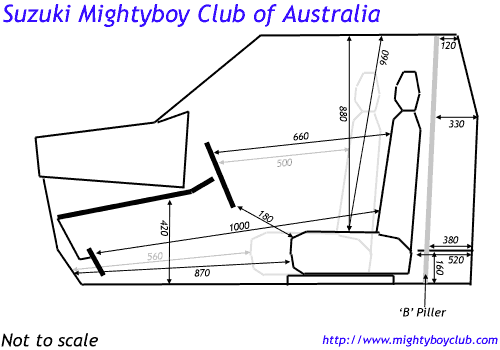
|
|
Car audio is another one of those much debated topics when it comes to cars. It is something that when done well looks and and sounds great. Sadly though, it is one of those things that is far too often overlooked or done either cheaply or installed badly (sometimes both). There are two types of car audio installations that people do; General audio - this is typical installation using usually, but not exclusively a head unit (the player or controller usually in the dash), one or sometimes two amplifiers, splits (a type of speaker combo which separates the mid/base from the tweeter speaker) and usually either a pair of 6x9 speakers or a subwoofer for bass. The other type of install is one for competition sound-off's. these are also called DB (decibels). The object of the competition is to get the highest DB reading through a sensitive microphone located at an exact point in every car. This is usually a set distance from the passenger side window and also from the windscreen. Competitors often use special comp CD's like 'Bass Mekanik' that play tones at particular frequencies. The setup for these usually involve
a head unit, usually many amplifiers and, depending of class, usually
many subwoofer's. This type of system is designed just for DB and
therefore only plays very deep bass. High end general systems also
can participate in these sound-off's and even have their own class,
but a lot of the time they turn their non-bass playing amps off. This
is to conserve all available power for the subs. A cap (capacitor)
is nearly always used in sound-off systems. A cap is a device that
stores power from your battery and delivers a set voltage at full
power to your amplifiers until it has completely exhausted it's own
reserves. An example is when a MB was at a sound-off, just with the
engine idling, there wasn't enough power it the little battery of
the car. A DB reading of only 121.8 was achieved, this being far below
expectation. Voltage was found to be lacking so a large cap was installed.
The maximum (allowable) voltage was dialed in and a re-test was done,
143.7DB was achieved. An enclosed box is great for very small volumes and is very responsive. As the subwoofer activities outwards, a vacuum is created thus quickly and efficiently returning the speaker to it's original position. Generally, not as good as other types of boxes but does offer sharp replication of a frequency. Ported box - A louder option able to 'push' more air. Nearly all comp boxes are ported or a variant there of. All sub chambers have large vents, thus allowing for smaller boxes. Band-pass box - Also a ported box, but usually with the front part of the subs also in closed, with the coil of the sub firing into the ported section. Usually very large boxes. These are quite flashy as usually two subs face each other on a 90 degree angle with perspex covering the front of the box. The original radio isn't standard
size. It's what's called a mini-cam design. To get a regular size
head unit to fit, modification must be made to the surrounding dash.
Alternatively, Phillips make a range of mini-cam size head units,
but their quality is not really made for performance audio. Brackets
are normally required for fitting the unit under the dash just below
the air vents. This gives easy access and allows adequate ventilation,
but also make it easily stolen. A center console are available from
car re-trimming shops or they can make one up for you. These console's
enclose your CD player making them harder to steel and some people
think they look better. AMPLIFIERS An addition to the above with a few corrections was submitted by Paul Barron, Thanks Paul. RMS Stands
for 'Root Mean Square' there are two types of measurement of RMS 2:- True RMS (the only correct figure) Is where a sine wave is measured from start of rise from base line to end eg.
+ +
Sorry for the maths an electrical lesson basically the formula to work it out is (Peak to Peak Value Times by .707) AMPS =
Volts / Resistance Watts / Voltage = AMPS (only usefull if you know the actuall voltage i know home stereo's plug into the wall we know there's 240VAC but the actuall amplifier circuit could be anything from 8V DC to 125V DC Speakers Mid range - Speakers varying in size from 3 - 6 inch. They play the middle frequencies very well. High quality speakers can also play both very high and very low frequencies well. Splits - A type of speaker combo which separates the mid/base from the tweeter speaker. Subwoofers - These speakers are usually larger than your normal ones. They can vary in size from 6 inch to usually the maximum of 15 inch, but some manufactures have limited release speakers to 1 Metre. They are designed to produce very low frequencies. A good quality sub has the ability to reproduce tones so low that you can't even hear them, yet you are able to see the speaker moving. (1-20hz) All subs have an optimum operating environment. Manufactures publish a particular speakers specifications from which you should design and build your box. The cables you use should always be high quality low-loss car audio cabling. In particular, the cable from your battery to your amp or cap should be a very high quality thick cable and gold plated points.
Dimensions Here are the dimensions within a MB, also the approximate dimensions for the largest sub box that would fit, and also be legal for competition sound-off's. Allowances must be made for seat belts and cable connection points.
The best reading known from a MB during a competition is 143.7.
This guide is only for ideas and should not be used exclusively as there are MANY other options to consider when fitting audio. This write up is the thoughts from the author
and may or may not be correct. If you have anything to add or question,
please feel free to email them here. |






